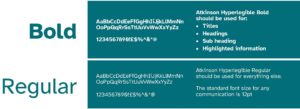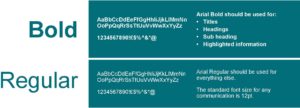Design use
Atkinson Hyperlegible
For our logo, we have chosen the font Atkinson Hyperlegible. The Braille Institute worked with Applied Design Works to develop the font and named it after their founder, J. Robert Atkinson.
This typeface was designed specifically to help with legibility and to improve readability for people with low vision and focuses on making it easy to distinguish between characters.
Atkinson Hyperlegible will be used only by the Design team to create campaign and marketing materials.

General use
Arial
For general documents and correspondence, staff should use the Arial font. This typeface is RNIB endorsed for its accessibility and has good clarity and legibility and is widely available for the majority of users.
All typography should be in sentence case and written clearly referencing our tone of voice.

Accessibility
Somerset Council aims to write and design content that is accessible to everyone who wishes to access it, regardless of any impairment or disability they may have.
Sometimes we will need to produce information in different ways for people to make sure all those using the Council’s services are able to understand the information.
To ensure readability text should:
- Be displayed at a minimum of 12pt and displayed in the correct font as described above
- Not be displayed using italics, underlines or block capitals
- Displayed on a clear, contrasting background in an accessible colour pairing (see the Colour accessibility matrix) – design elements must not overlap or intersect text.
- Be displayed in a single column
- Be left-aligned (and not justified)


